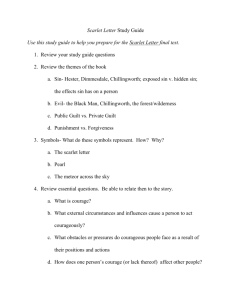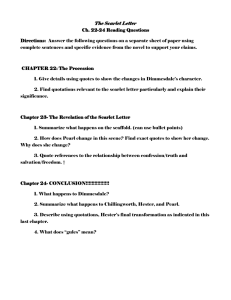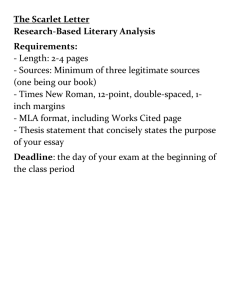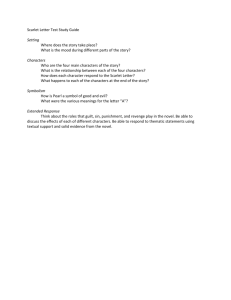The Scarlet Letter
advertisement
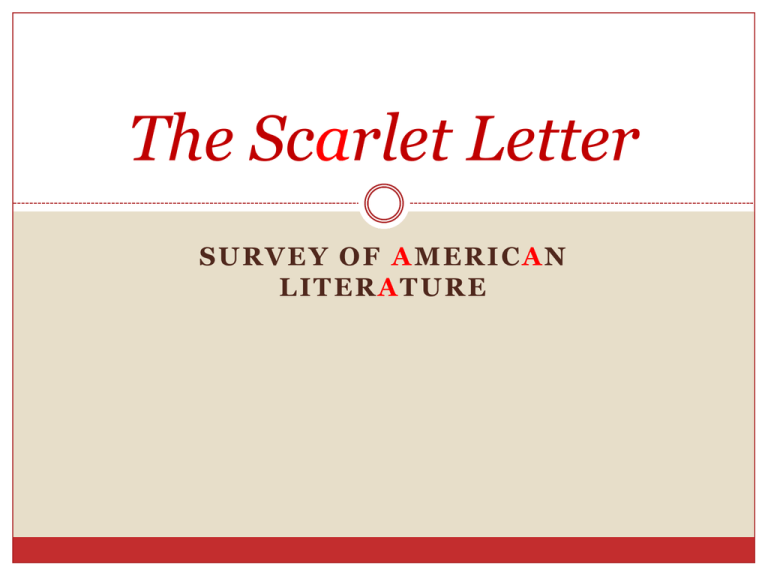
The Scarlet Letter SURVEY OF AMERICAN LITERATURE Nathaniel Hawthorne About the Man 1804-1864 Salem, Massachusetts Puritan Solid accomplishment Great guilt Ancestor: William Hathorne Married Sophia Peabody Strength and nobility Reflected in Hester Prynne Nathaniel Hawthorne About the Author Great American Author First psychological novel Redemption, sin Romanticism Intellectual curiosity Optimism Dark Romanticism Works Novels Short Stories The Scarlet Letter Written in 1855 Setting Boston Mid-1600s Seven-year period Framework Rigid social mores Traditional customs Moral attitudes Religious beliefs The Scarlet Letter Plot Love triangle: wife-lover-husband Struggle: good versus evil Characters’ souls at stake Suspense Will identities of lover and husband be revealed? How will identities be revealed? Psychological movement: husband’s quest for revenge The Scarlet Letter Structure Innovative form Instead of ongoing chronicle of events Series of separate, fully-realized chapters Interspersed with expository chapters Novel begins in media res Action already occurred Characters facing consequences The Scarlet Letter Point of View (POV) Omniscient Author reveals inner and outer characters Asides Social criticism History Psychology All characters in constant state of change Theocracy Act of adultery not important Consequences of adultery more important Major Characters Hester Prynne Novel’s heroine Adulterer Name: prim and proper First strong female character in American literature Major Characters Pearl Hester’s daughter Illegitimate child Product of adultery Precious to her mother Intelligent, imaginative Major Characters Arthur Dimmesdale Reverend Guilt-ridden Tortured Major Characters Roger Chillingworth Scholar Vengeful Hides true identity Themes Effects of Sin and Possibility of Redemption Psychological and social consequences of sin Characters’ processes of redemption Does every attain redemption? Applies to: Hester Dimmesdale Chillingworth Secondary Effect: Insight into the Hearts of Others Themes Hypocrisy Conflict between outer appearance and inner reality Depicted in Hester’s relationship with community Illustrated in portrayals of Dimmesdale and Chillingworth Other Noticeable Themes Guilt Revenge Human frailty and Sin Conflicts Man versus Society Man versus Man Man versus Self Symbols The Scarlet Letter Central symbol of novel Meaning changes as characters change The Scaffold Public exposure of private since Redemption through confession Elements of Nature Good and evil Forest is changeable symbol for both Irony Dramatic Irony Controls novel Readers know something about a character the other characters do not If characters knew what readers know, plot would be ruined Situational Irony Central to novel’s action Contrast between intention of an action and its result Expectations aroused by situation are reversed Verbal Irony Throughout novel What happens when a private sin becomes a public crime?

